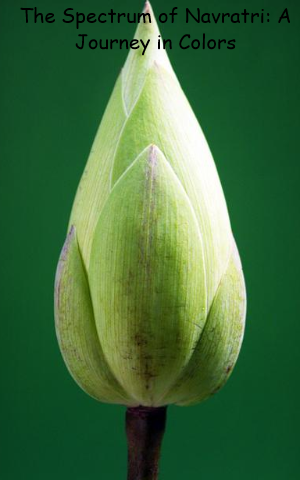The Spectrum Of Navratri: A Journey In Colors
The Spectrum Of Navratri: A Journey In Colors


In the heart of a vibrant village, nestled in the lap of nature, there lived a woman named Meera. She was a devout follower of Navratri, a festival that celebrated the divine feminine energy, Nav Durga. Each year, Meera eagerly awaited the nine nights of Navratri when she would adorn herself in the colours representing the different facets of the Mother Goddess.
Day 1: The Purity of White
The festival began with the serene white of purity. Meera wore a pristine white saree, symbolizing the purity of intentions. She cleaned her home and heart, leaving behind the dust of worldly concerns. The first day was dedicated to Shailaputri, the embodiment of the mountains, strong and unwavering.
Day 2: The Passionate Red
On the second day, she donned a fiery red outfit. This colour, representing passion, reminded her that life was not meant to be lived in monotony. It was dedicated to Brahmacharini, the Goddess of asceticism and devotion. Meera felt the intensity of her own desires and the power of her inner fire.
Day 3: The Divine Royal Blue
The third day arrived, and Meera dressed in royal blue. This deep hue symbolized divine energy. It was an ode to Chandraghanta, the one who bestows peace and grace. Meera felt a sense of calm amidst the chaos, as she connected with her own divinity.
Day 4: The Joyful Yellow
As the festival continued, Meera chose a bright yellow attire on the fourth day. Yellow stood for joy and cheerfulness, dedicated to Kushmanda, the creator of the universe. Meera danced with glee, celebrating the creation that surrounded her.
Day 5: The Nourishing Green
On the fifth day, Meera embraced the colour green, symbolizing the nourishing aspects of Mother Nature. The day honoured Skandamata, the mother of Kartikeya. Meera felt a deep connection to the earth and realized the importance of preserving it for generations to come.
Day 6: The Deceptive Grey
The sixth day was cloaked in grey, representing the destruction of evil. It was dedicated to Katyayani, the fierce warrior form of Durga. Meera understood that sometimes, to build anew, one must destroy the old, just as nature did with its storms and fires.
Day 7: The Bright Orange
The seventh day arrived, and Meera adorned herself in bright orange, symbolizing fire and knowledge. It was the day of Kalaratri, the fierce destroyer of darkness. Meera embraced the flames of knowledge, banishing ignorance from her heart.
Day 8: The Desires in Peacock Green
The eighth day brought a peacock green ensemble. This colour represented fulfilled desires and was dedicated to Mahagauri, the one who fulfils wishes. Meera prayed for her heart's desires, knowing that with faith and devotion, they would be granted.
Day 9: The Feminine Pink
On the final day, Meera donned a soft pink saree. Pink symbolises purity and femininity, a tribute to Siddhidatri, the Goddess who grants spiritual perfection. Meera recognized the divine feminine within herself, embracing her strength and gentleness.
As the ninth night of Navratri concluded, Meera felt a profound sense of spiritual growth. The colours of Navratri had guided her through a transformative journey, reminding her of the power within and the importance of balance in life.
Navratri, for Meera, was not just a festival of colours but a celebration of life's diverse hues, each reflecting a different facet of her own existence. It was a reminder that within her, she held the essence of the divine Mother, capable of love, strength, and boundless compassion.






























































